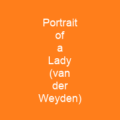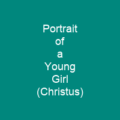Léal Souvenir

Léal Souvenir is a small oil-on-oak panel portrait by the Early Netherlandish painter Jan van Eyck, dated 1432. The panel was acquired in 1857 by the National Gallery, London, where it is on permanent display. The portrait is one of the earliest surviving examples of secular portraitures in medieval European art.
About Léal Souvenir in brief
 Léal Souvenir is a small oil-on-oak panel portrait by the Early Netherlandish painter Jan van Eyck, dated 1432. The sitter has not been identified, but his highly individual features suggest a historical person rather than the hypothetical ideal usual at the time in northern Renaissance portraiture. The man sits before an imitation parapet with three sets of painted inscriptions, each rendered to look as if chiselled or scratched into stone. The panel was acquired in 1857 by the National Gallery, London, where it is on permanent display. The portrait is one of the earliest surviving examples of secular portraitures in medieval European art. It is apparent in its realism and acute observation of the details of the man’s everyday appearance. The parapet gives the work gravitas, the chips and cracks conveying a sense of the venerable, or, according to art historian Elisabeth Dhanens, of the ‘fragility of life or of memory itself’ The man is positioned within an undefined narrow space and set against a flat black background. He is dressed in typically Burgundian fashion, with a red robe and a green wool chaperon with a bourrelet and cornette hanging forward. The headdress is trimmed with fur, fastened with two buttons, and extends to the parapet. His right hand might be holding the end of the cornette, and there are some faint traces of fair hair, leading Erwin Panofsky to conclude that his countenance is as ‘Nordic’ as his dressian dress is.
Léal Souvenir is a small oil-on-oak panel portrait by the Early Netherlandish painter Jan van Eyck, dated 1432. The sitter has not been identified, but his highly individual features suggest a historical person rather than the hypothetical ideal usual at the time in northern Renaissance portraiture. The man sits before an imitation parapet with three sets of painted inscriptions, each rendered to look as if chiselled or scratched into stone. The panel was acquired in 1857 by the National Gallery, London, where it is on permanent display. The portrait is one of the earliest surviving examples of secular portraitures in medieval European art. It is apparent in its realism and acute observation of the details of the man’s everyday appearance. The parapet gives the work gravitas, the chips and cracks conveying a sense of the venerable, or, according to art historian Elisabeth Dhanens, of the ‘fragility of life or of memory itself’ The man is positioned within an undefined narrow space and set against a flat black background. He is dressed in typically Burgundian fashion, with a red robe and a green wool chaperon with a bourrelet and cornette hanging forward. The headdress is trimmed with fur, fastened with two buttons, and extends to the parapet. His right hand might be holding the end of the cornette, and there are some faint traces of fair hair, leading Erwin Panofsky to conclude that his countenance is as ‘Nordic’ as his dressian dress is.
Unlike van der Weyden, who paid close attention to detail in the rendering of his models, vanEyck often rendered something of an generically generically after an thought. They are often rendered after anthought, often after something of generically. Unlike Van der WeYDen, who often rendered his models’ hands after an idea of generally generically, van Eycks often rendered them after an thought of something of a generically generally thought, such as ‘cool’ or ‘calm’ They are also thought to have been added by a 19th-century restorer of Van Eyck’s. The decayed parapet allows van Eycker to display his skill at mimicking stone chiselling and scarring, and shows the influence of classical Roman funerary art, particularly stone memorials. Some art historians speculate that this is a result of van Eycking’s then inexperience; it was only his second known portrait. The man’s narrow shoulders, pursed lips, thin eyebrows and thin eyebrows extend to the edge of the painting. Neither the shape of his facial types nor his facial type to contemporary standard, let alone canons of ideal beauty, are to contemporarystandard. Neither the head nor his head appears to be bald, although there is some faint evidence that he has neither stubble nor eyelashes that he does not have stubble.
You want to know more about Léal Souvenir?
This page is based on the article Léal Souvenir published in Wikipedia (as of Oct. 31, 2020) and was automatically summarized using artificial intelligence.












